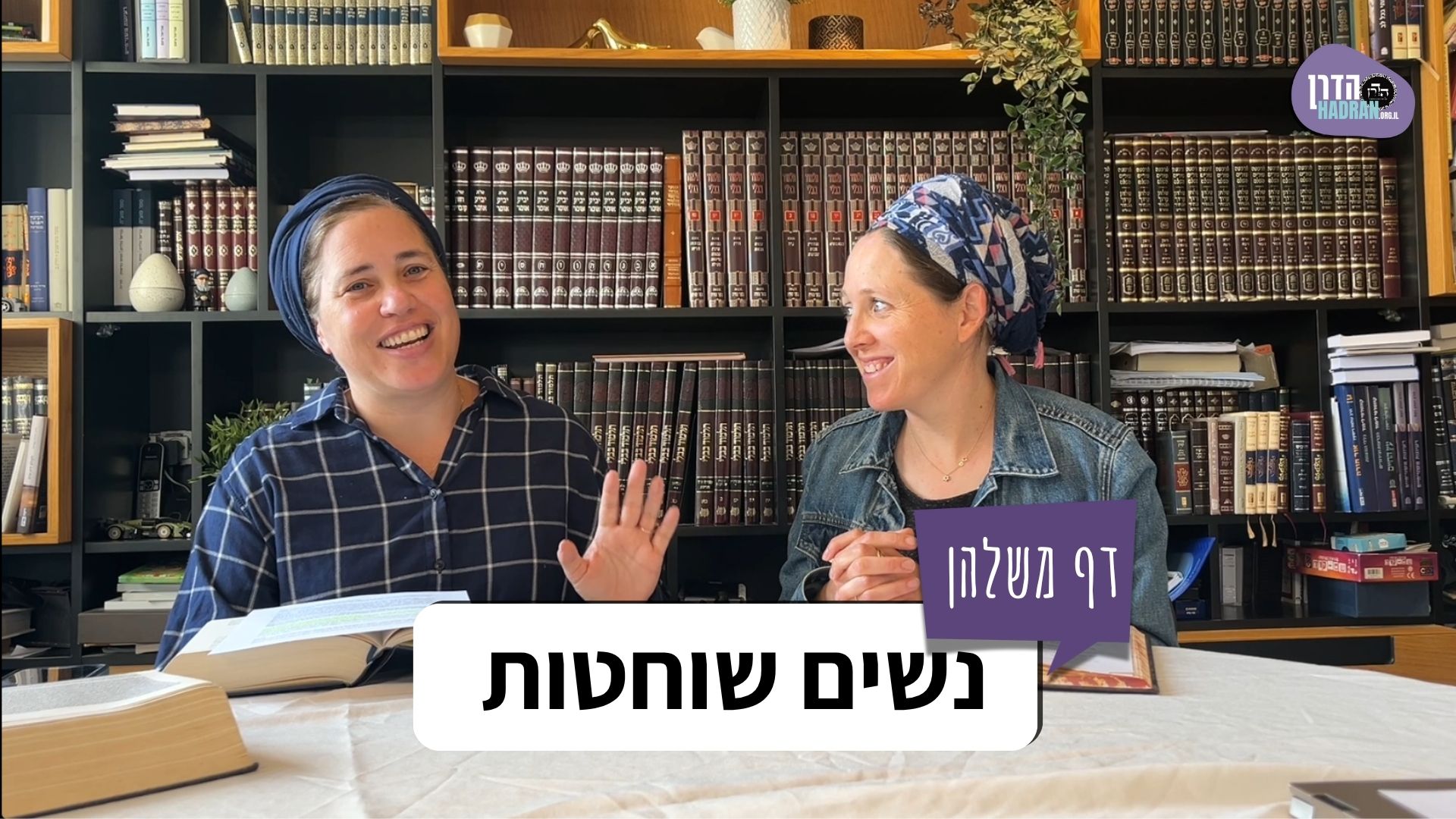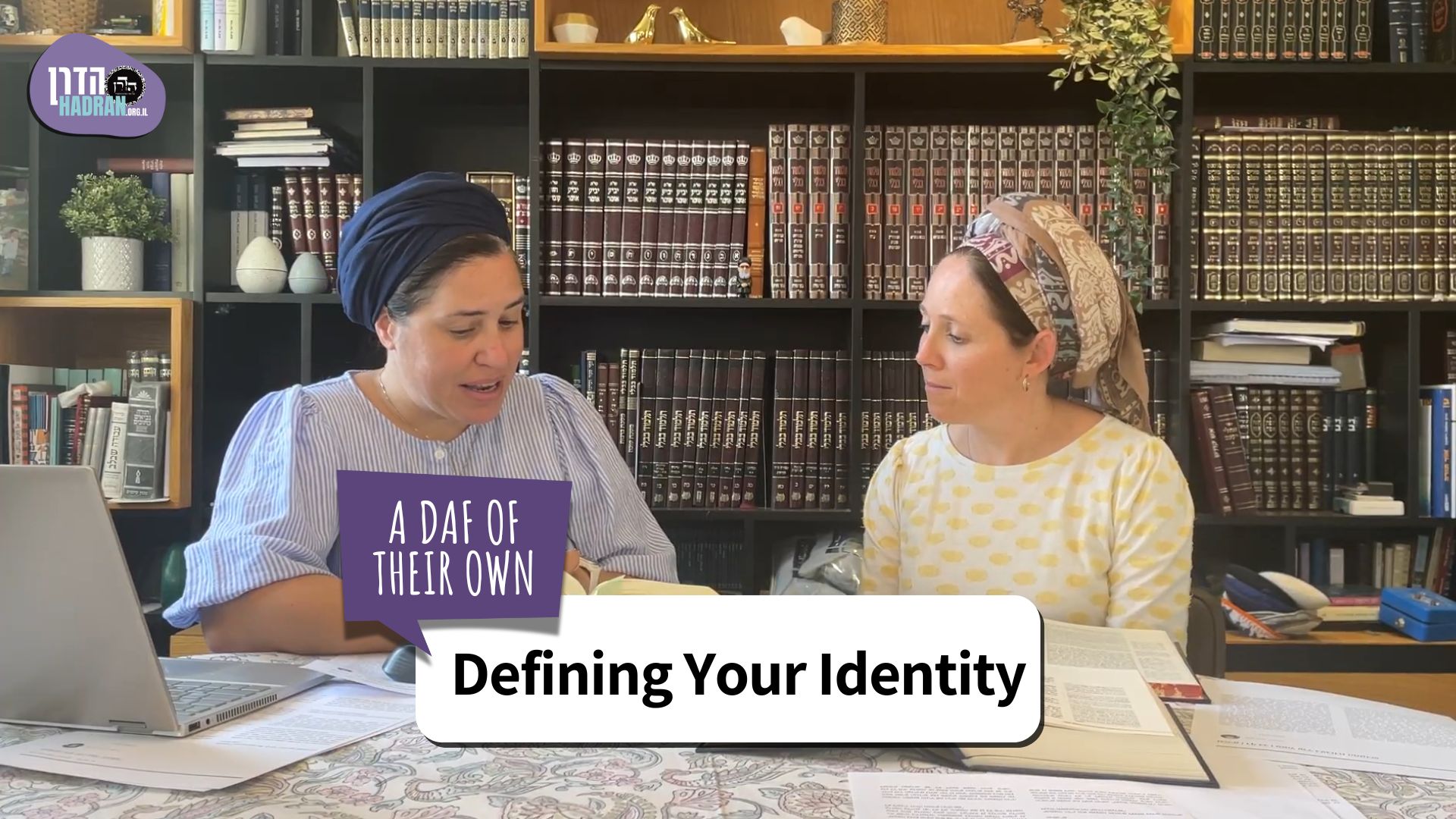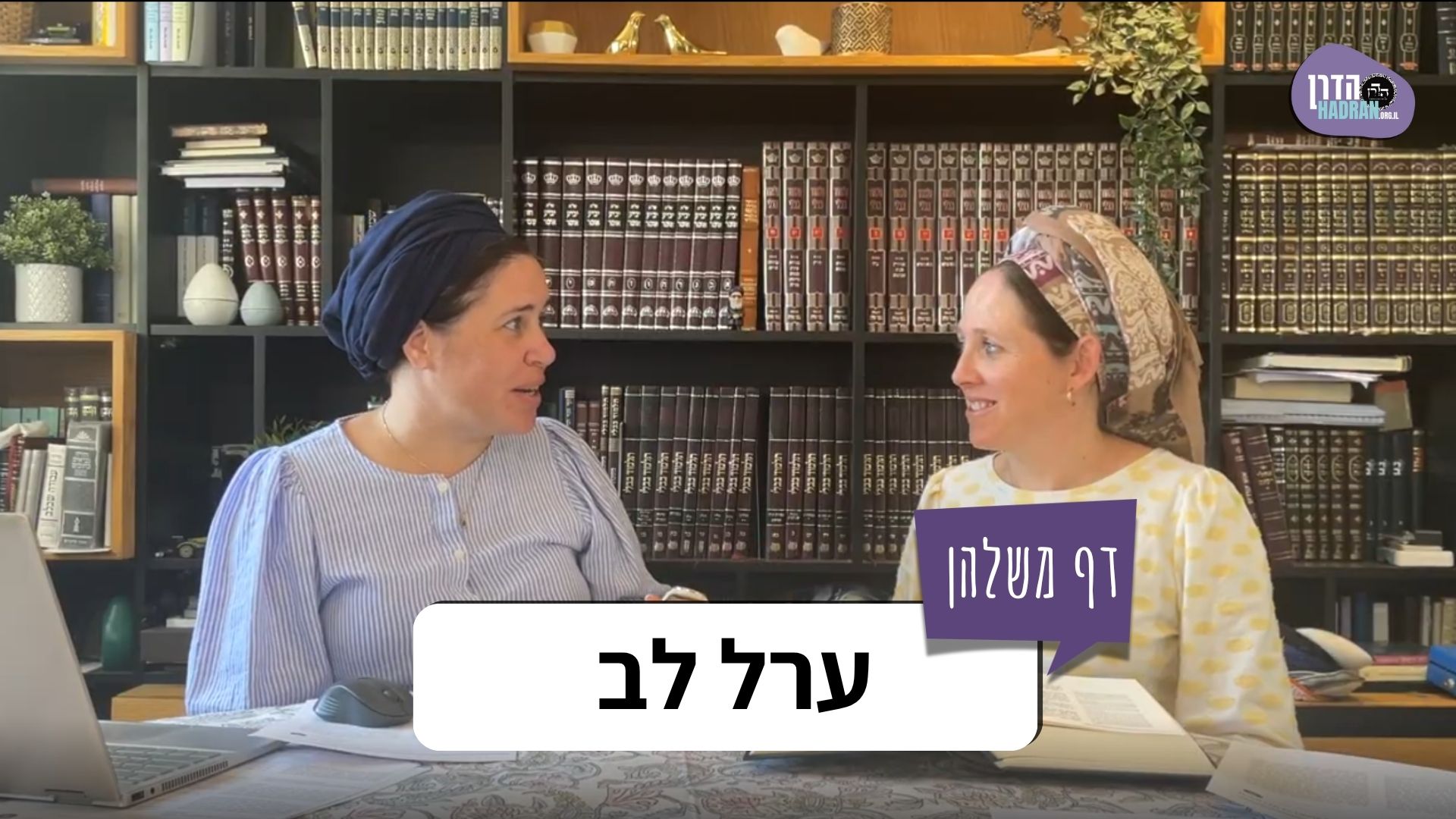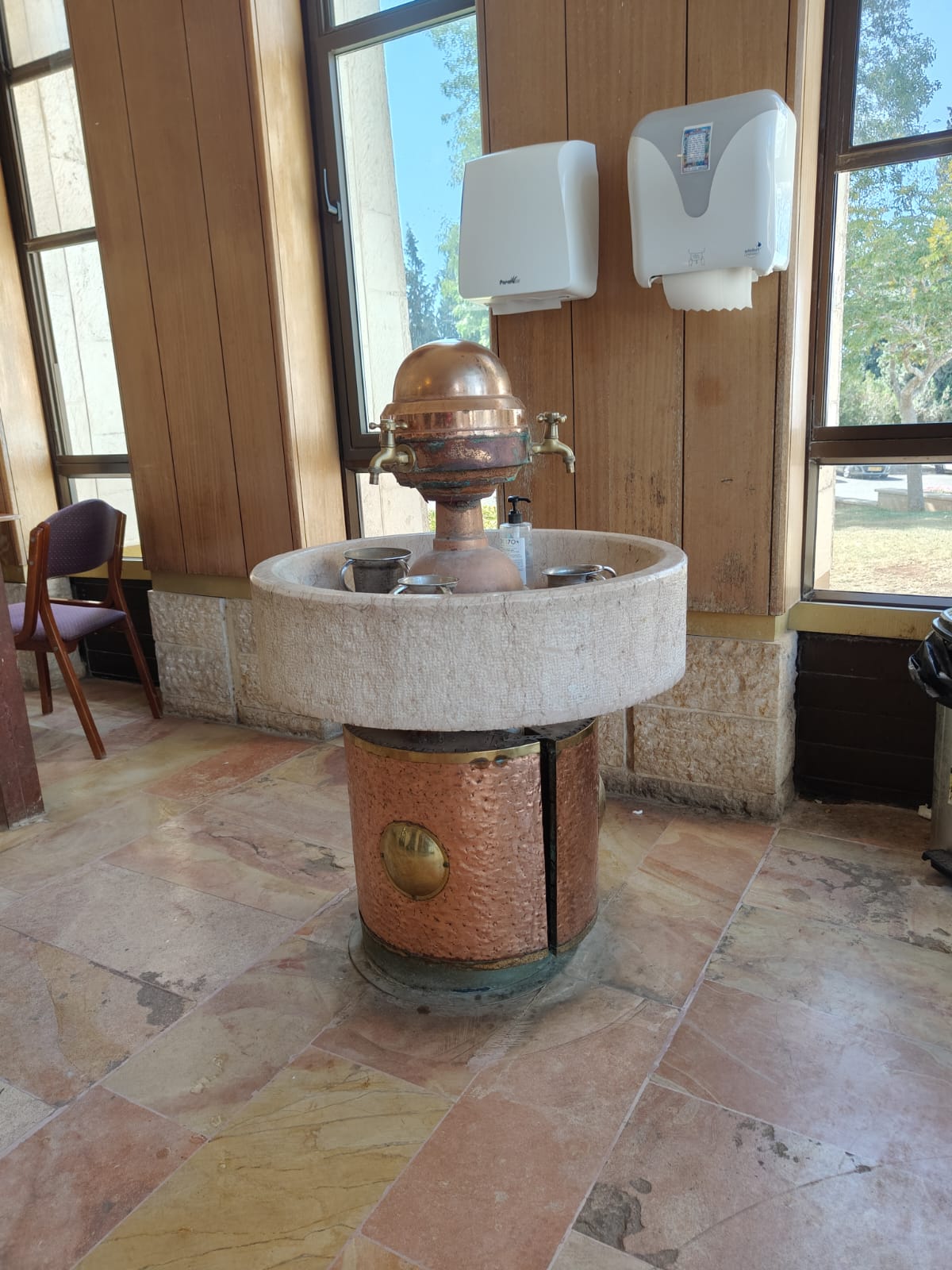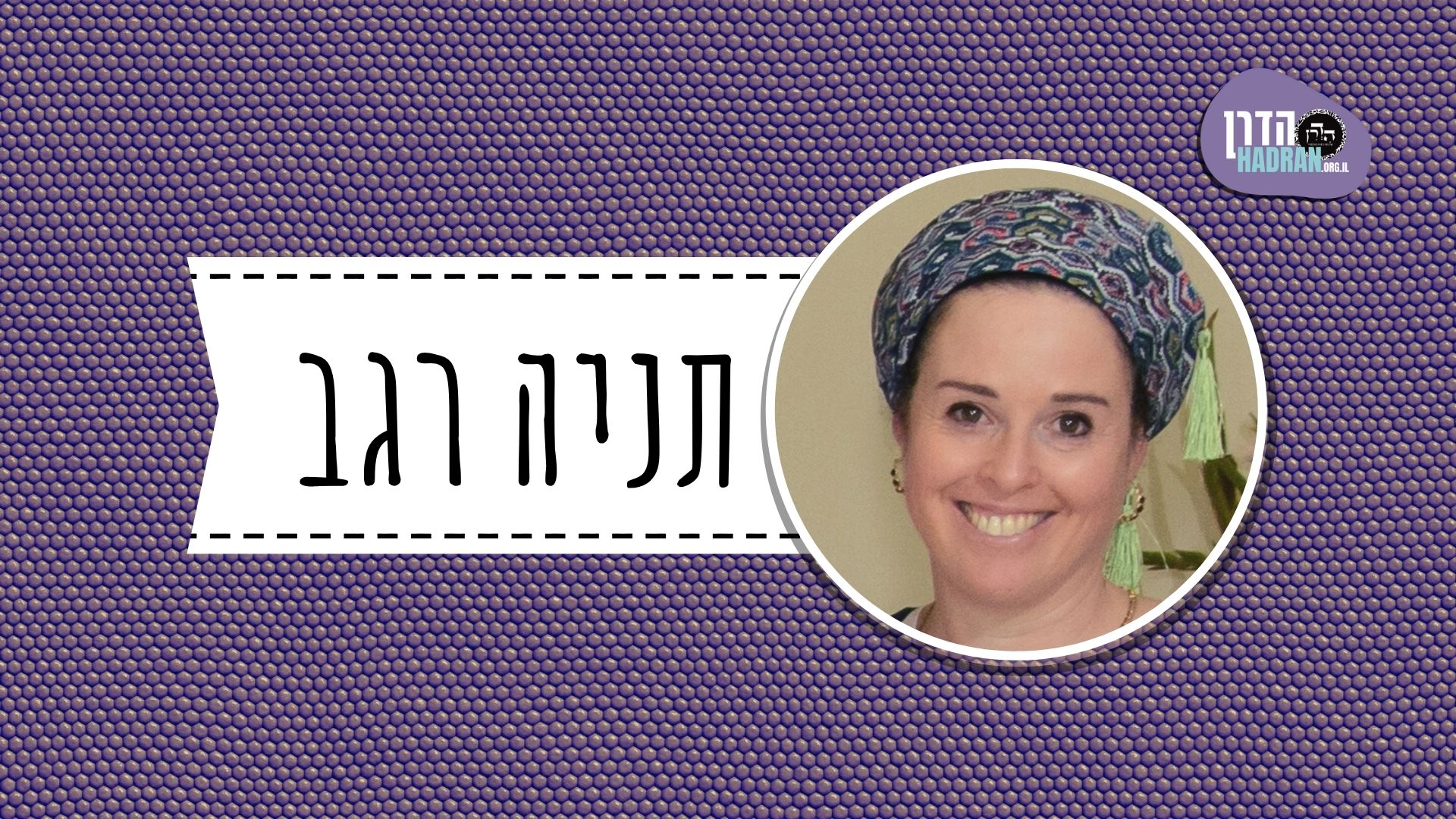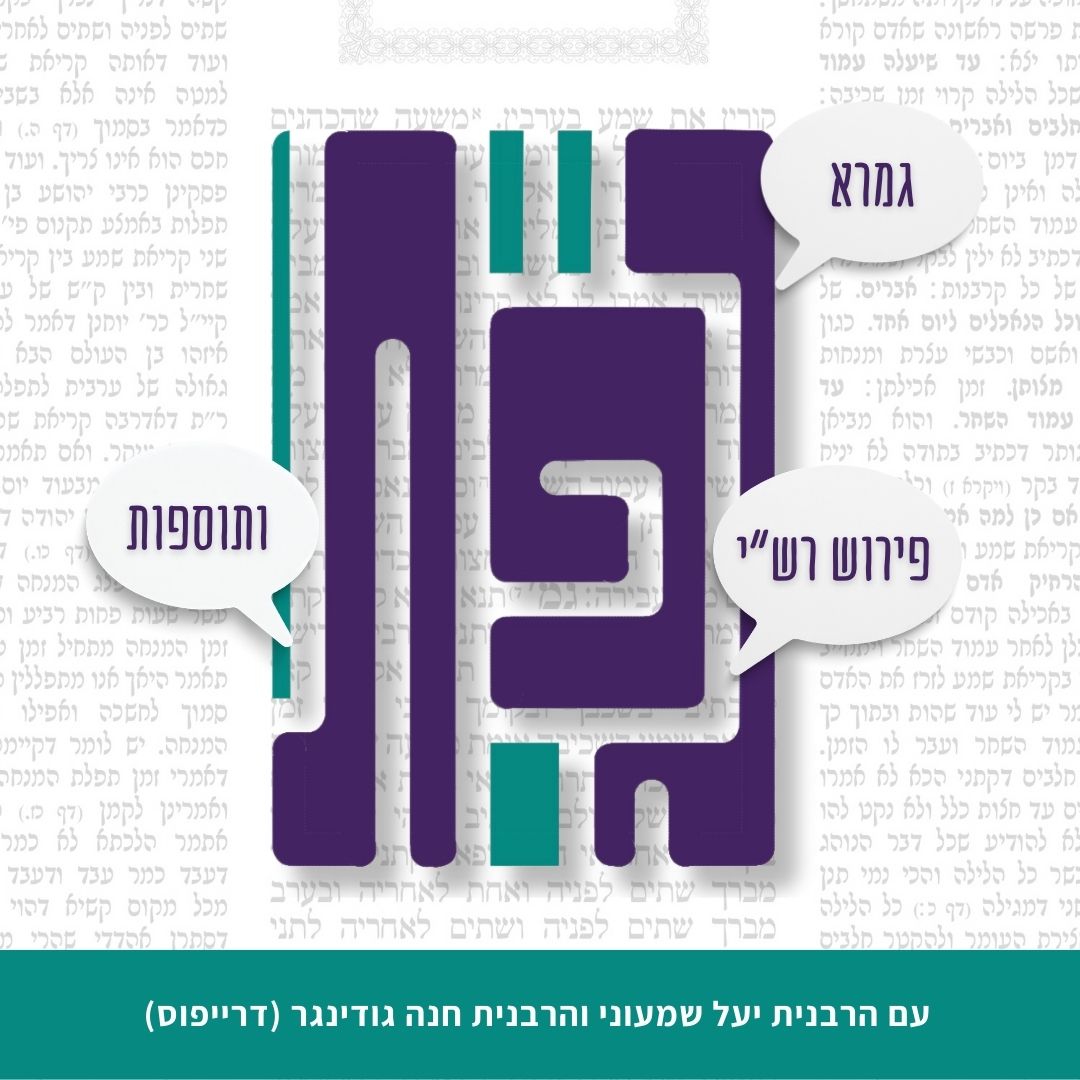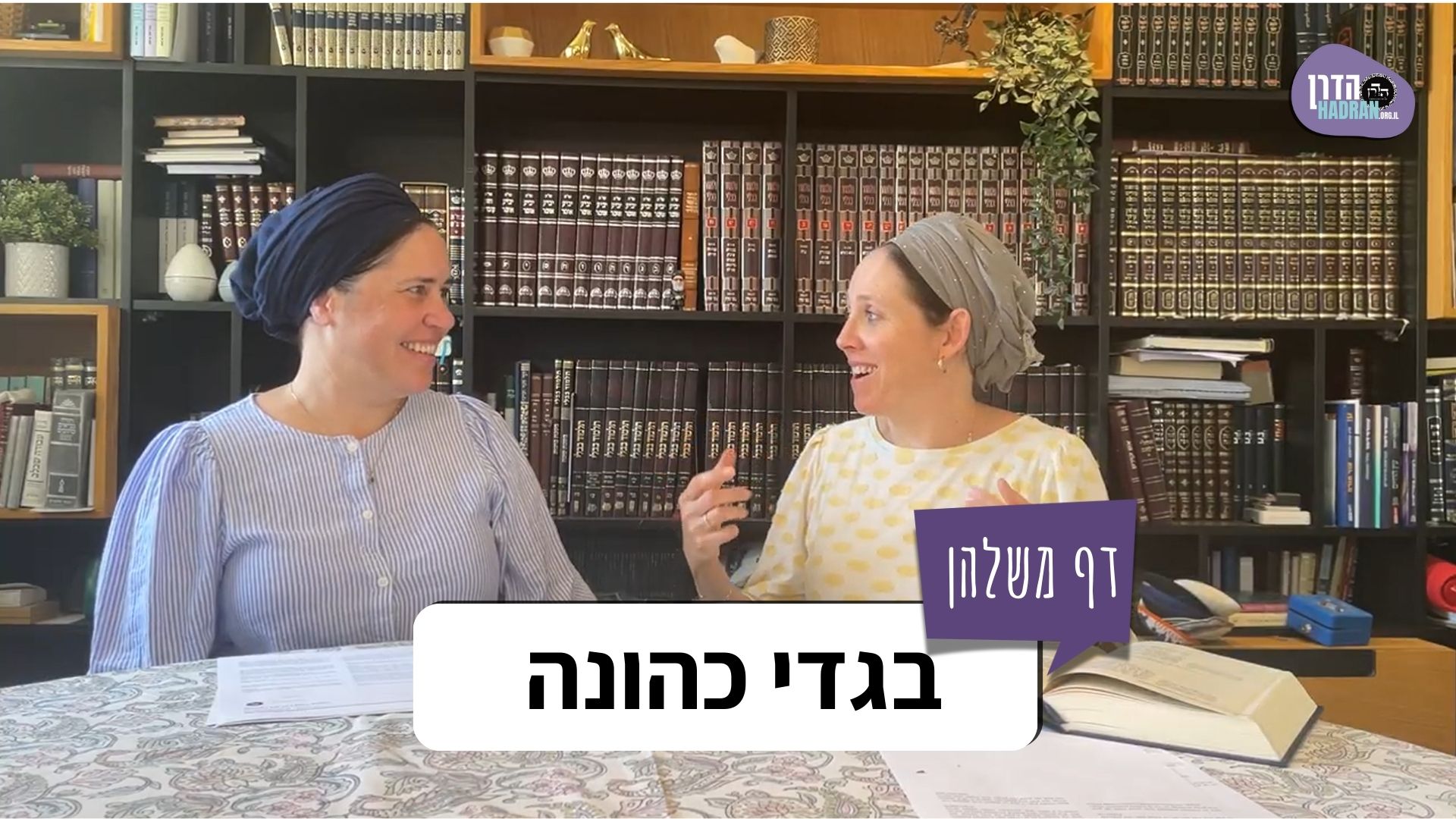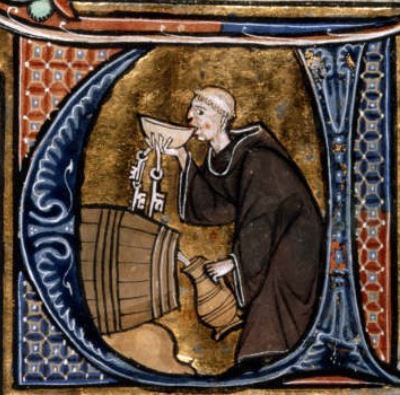Details regarding broken bones – in which cases does it create a treifa? Is the placenta of an animal permitted through laws of pen pekua? Under what circumstances? There is a discussion regarding superstitions and when they are forbidden/permitted.
This month’s learning is sponsored by Beth Balkany in honor of their granddaughter, Devorah Chana Serach Eichel. “May she grow up to be a lifelong learner.”
Want to dedicate learning? Get started here:


This month’s learning is sponsored by Beth Balkany in honor of their granddaughter, Devorah Chana Serach Eichel. “May she grow up to be a lifelong learner.”
Delve Deeper
Broaden your understanding of the topics on this daf with classes and podcasts from top women Talmud scholars.
New to Talmud?
Check out our resources designed to help you navigate a page of Talmud – and study at the pace, level and style that fits you.
The Hadran Women’s Tapestry
Meet the diverse women learning Gemara at Hadran and hear their stories.
Chullin 77
נמנין עליהן בפסח ועוד התורה חסה על ממונן של ישראל
one may be registered as part of a group that will eat the Paschal offering on their account, i.e., even if those sinews are the only part of the lamb he will eat. Evidently, such sinews are regarded as flesh. And furthermore, the Torah spared the money of the Jewish people, and one must tend toward leniency.
א”ל רב פפא לרבה ר”ש בן לקיש ואיסורא דאורייתא ואת אמרת מאי ליחוש להו אישתיק
Rav Pappa said to Rabba: But Rabbi Shimon ben Lakish disagrees with Rabbi Yoḥanan and holds that one may not be registered for those sinews, as they will eventually harden and are therefore not considered flesh. And therefore, the broken bone in this case is not covered by flesh and the animal is prohibited by Torah law as a tereifa, and yet you say: What concern is there with the sinews in this case? Rabba was silent.
ואמאי אישתיק והאמר רבא הלכתא כוותיה דר”ש בן לקיש בהני תלת
The Gemara asks: And why was Rabba silent? But doesn’t Rava say that the halakha is in accordance with the opinion of Rabbi Shimon ben Lakish in his disputes with Rabbi Yoḥanan only with regard to these three matters, i.e., three matters that are mentioned in Yevamot 36a, and not in other cases? If so, Rabba could simply have replied that the halakha is not in accordance with the opinion of Rabbi Shimon ben Lakish with regard to this issue.
שאני הכא דהדר ביה ר’ יוחנן לגביה דר”ש בן לקיש דא”ל אל תקניטני בלשון יחיד אני שונה אותה
The Gemara answers: Here, with regard to sinews that will ultimately harden, it is different, as Rabbi Yoḥanan retracted his ruling in favor of the opinion of Rabbi Shimon ben Lakish, as when Rabbi Shimon ben Lakish raised a difficulty against Rabbi Yoḥanan’s opinion, Rabbi Yoḥanan said to him: Do not provoke me by asking questions to refute my opinion that the fact that the sinews will ultimately harden is disregarded, as I teach it in explanation of a lone opinion (see Pesaḥim 84a). Even Rabbi Yoḥanan conceded that the opinion he expressed was only according to one Sage, but is not the halakha.
ההוא נשבר העצם ויצא לחוץ דאישתקיל קורטיתא מיניה אתא לקמיה דאביי שהייה תלתא ריגלי
The Gemara relates: There was a certain case in which a bone in an animal’s leg broke and protruded outward. This bone was mostly covered with flesh and skin, but a small piece [kurtita] of the bone had been removed from it. The case came before Abaye, who delayed his response until three pilgrimage Festivals had passed, when the Sages gathered together and he could ask them.
א”ל רב אדא בר מתנא זיל קמיה דרבא בריה דרב יוסף בר חמא דחריפא סכיניה אתא לקמיה אמר מכדי נשבר העצם ויצא לחוץ תנן מה לי נפל מה לי איתיה
Rav Adda bar Mattana said to the owner of the animal: Go before Rava, son of Rav Yosef bar Ḥama, whose knife is sharp, i.e., he has insight into halakhic matters and decides matters quickly, and ask him to decide your case. The owner came before Rava to seek his opinion. Rava said to him: Since we learned in the baraita (76b): If the bone broke and protruded outward, if skin and flesh cover a majority of the bone the animal is permitted, what difference is there to me if the bone fell out, and what difference is there to me if it is in its place? In either case, the animal is permitted.
א”ל רבינא לרבא מתלקט מה מתרוסס מהו מתמסמס מהו היכי דמי מתמסמס אמר רב הונא בריה דרב יהושע כל שהרופא קודרו
With regard to a case where flesh covers the majority of a broken bone, Ravina said to Rava: If the flesh was torn in pieces and spread over the area, and if gathered it would constitute a majority, what is the halakha? Similarly, if the flesh was pulverized and thin, what is the halakha? If it was decomposed, what is the halakha? The Gemara asks: What are the circumstances of this case in which the flesh is decomposed? Rav Huna, son of Rav Yehoshua, said: This is referring to any kind of flesh that the doctor cuts away [kodro] and removes to enable the surrounding area to heal.
איבעיא להו ניקב מהו נקלף מהו נסדק מהו ניטל שליש התחתון מהו
A dilemma was raised before the Sages: If the flesh that covers the bone was perforated, what is the halakha? Likewise, if the flesh was peeled off the bone, what is the halakha? If it was cracked, what is the halakha? If the bottom third of the width of the flesh, i.e., the part that is adjacent to the bone, was removed, what is the halakha?
ת”ש דאמר עולא אמר ר’ יוחנן עור הרי הוא כבשר דלמא דקנה משכא דידיה
The Gemara suggests: Come and hear, as Ulla says that Rabbi Yoḥanan says: Skin is like flesh. This would appear to indicate that any covering is sufficient. The Gemara refutes this proof: Perhaps Rabbi Yoḥanan was referring to a specific case where there was never flesh on the bone, but only skin, e.g., adjacent to the knee, where the skin holds its own place close to the bone. This ruling may not apply in an area where there was flesh. Perhaps in such a place the bone must be covered by flesh that is still healthy.
אמר רב אשי כי הוינן בי רב פפי איבעיא לן נקדר כמין טבעת מהו ופשטנא מהא דאמר רב יהודה אמר רב דבר זה שאלתי לחכמים ולרופאים ואמרו מסרטו בעצם ומעלה ארוכה אבל פרזלא מזרף זריף אמר רב פפא והוא דקנה גרמא דידיה:
Rav Ashi said: While we were studying in Rav Pappi’s study hall, we raised a dilemma: If the flesh and skin were cut in the shape of a ring around the break, and yet most of the circumference of the bone is surrounded by flesh, what is the halakha? And we resolved this dilemma from this statement that Rav Yehuda says that Rav says: I asked about this matter to the Sages and to the doctors, what to do when a bone breaks and the surrounding flesh has been cut away, and they said: One makes an incision in it with a sharp piece of bone to help the blood flow and then congeal, and in this manner the wound will heal. The Gemara notes: But one should not make the incision with an iron implement, as it will cause inflammation. Rav Pappa said: And this advice should be implemented only in a case where one can see that the bone is holding firmly onto its flesh, as only in such a case will the flesh heal.
מתני׳ השוחט את הבהמה ומצא בה שליא נפש היפה תאכלנה ואינה מטמאה לא טומאת אוכלין ולא טומאת נבלות חישב עליה מטמאה טומאת אוכלין אבל לא טומאת נבלות
MISHNA: In the case of one who slaughters an animal and finds a placenta in its womb, one with a hearty soul [nefesh hayafa], i.e., who is not repulsed by it, may eat it, as its consumption was permitted by virtue of the slaughter of the mother. Nevertheless, since generally speaking, people do not consume such placentas, it is not regarded as food and so it cannot become impure with the ritual impurity of food even were it to come into contact with a source of impurity. And furthermore, it does not impart the ritual impurity of animal carcasses as it was permitted by virtue of the slaughter of the mother. But if one intended to eat it, one thereby elevated it to the status of food, and the placenta becomes impure with the ritual impurity of food if it comes into contact with a source of impurity. But even so, it still does not impart the ritual impurity of animal carcasses.
שליא שיצתה מקצתה אסורה באכילה סימן ולד באשה וסימן ולד בבהמה
With regard to a placenta, part of which emerged from the womb before the mother was slaughtered, its consumption is prohibited even after the mother animal is slaughtered because the emergence of the placenta is an indication of a fetus in a woman and an indication of a fetus in an animal. Accordingly, there is a concern that the head of the fetus might have emerged in that part of the placenta, thereby rendering the fetus as having been born, a status that precludes it from being permitted by the slaughter of its mother. Since the offspring is prohibited, its placenta is likewise prohibited.
המבכרת שהפילה שליא ישליכנה לכלבים ובמוקדשין תקבר ואין קוברין אותה בפרשת דרכים ואין תולין אותה באילן מפני דרכי האמורי:
If an animal that was giving birth to its firstborn expelled a placenta, one may cast it to the dogs, and one does not need to be concerned that the placenta came from a male fetus that has the consecrated status of a firstborn. But in the case of sacrificial animals the placenta must be buried, because it came from a fetus that is assumed to have been sacred. The mishna adds: But one may neither bury it at an intersection, nor may one hang it on a tree, superstitious rites intended to prevent the animal from miscarrying again, due to the prohibition against following the ways of the Amorite, which prohibits Jews from practicing the superstitious rites observed by gentiles.
גמ׳ מנא הני מילי דת”ר (דברים יד, ו) כל בהמה תאכלו לרבות את השליא יכול אפילו יצתה מקצתה ת”ל אותה אותה ולא שליתה
GEMARA: With regard to the ruling that a placenta is permitted by virtue of the mother’s slaughter, the Gemara asks: From where is this matter derived? As the Sages taught: “And every animal that parts the hoof, and has the hooves wholly cloven in two, and chews the cud, of the animals, it you may eat” (Deuteronomy 14:6). The verse is the source of the halakha that a fetus is permitted by virtue of the mother’s slaughter (see 69a). The word “every” at the beginning of the verse serves to include the placenta as well as the fetus. One might have thought that a placenta is permitted even if part of it emerged from the womb before slaughter. Therefore, the verse states: “It you may eat,” i.e., you may eat it, the slaughtered animal, but not its placenta, if it partially emerged.
מכדי אין שליא בלא ולד למה לי קרא קרא אסמכתא בעלמא:
The Gemara objects: Now the assumption is that there is no placenta without a fetus. Therefore, if part of the placenta emerged, there is a concern that the head of the fetus might have emerged in that part of the placenta, thereby rendering the fetus as having been born. Such a status would preclude it from being permitted by the slaughter of its mother. Why do I need a verse to teach this? The Gemara explains: The verse is a mere support for the halakha, but not the source for it.
ואינה מטמאה: בעי ר’ יצחק בר נפחא עור חמור ששלקו מהו למאי אי לטומאת אוכלין תנינא
§ The mishna states: And a placenta found inside a slaughtered animal cannot become impure with the ritual impurity of food and does not impart the ritual impurity of animal carcasses. In a related discussion, Rabbi Yitzḥak bar Nappaḥa raises a dilemma: A donkey hide that one cooked and it became softened, what is its halakhic status? The Gemara asks: With regard to what issue did he raise this dilemma? If it was with regard to the ritual impurity of food, we already learn this halakha in a baraita,
אי לטומאת נבלות תנינא
and if you say it was with regard to the ritual impurity of animal carcasses, we already learn that halakha as well in another baraita.
טומאת אוכלין דתניא העור והשליא אין מטמאין טומאת אוכלין עור ששלקו והשליא שחישב עליה מטמאין טומאת אוכלין
The Gemara elaborates: With regard to the ritual impurity of food, it is as it is taught in a baraita: The hide and the placenta of an animal, which people do not typically eat, cannot become impure with the ritual impurity of foods. But a hide that one cooked until it became edible and a placenta that one intended to eat can become impure with the impurity of foods.
טומאת נבילות נמי תנינא (ויקרא יא, לט) בנבלתה ולא בעור ולא בעצמות ולא בגידין ולא בקרנים ולא בטלפים
With regard to the ritual impurity of animal carcasses also, we already learn in a baraita: The verse states: “And when a domesticated animal dies, of those that you eat, one who touches its carcass shall be impure until the evening” (Leviticus 11:39). The verse indicates that one is rendered impure if he touches its carcass, but not if he touches its hide, and not its bones, and not its sinews, and not its horns, and not its hooves.
ואמר רבה בר רב חנא לא נצרכה אלא שעשאן ציקי קדרה
And Rabba bar Rav Ḥana said with regard to this baraita: This derivation is necessary only for a case in which one prepared these parts of the animal as a meat pudding [tzikei kedera], in which they are cooked for an extended period and spices are added. One might have thought they would be considered edible flesh and therefore impart the impurity of a carcass. The baraita therefore teaches that this is not so.
לעולם טומאת אוכלין ושאני עור חמור דמאיס:
Given these two baraitot, why did Rabbi Yitzḥak Nappaḥa inquire about the status of the cooked hide of a donkey? The Gemara answers: Actually, Rabbi Yitzḥak Nappaḥa was inquiring about the impurity of foods, and although the halakha was already taught in the first baraita, Rabbi Yitzḥak Nappaḥa thought it is possible that the hide of a donkey is different, as it is repulsive and perhaps even when cooked it is not regarded as food.
שליא שיצתה: א”ר אלעזר לא שנו אלא שאין עמה ולד אבל יש עמה ולד אין חוששין לולד אחר ור’ יוחנן אמר בין אין עמה ולד בין יש עמה ולד חוששין לולד אחר
§ The mishna states: With regard to a placenta, part of which emerged from the womb before the mother was slaughtered, its consumption is prohibited, as there is a concern that the head of the fetus might have emerged in that part of the placenta. Commenting on this mishna, Rabbi Elazar says: The Sages taught this halakha only in a case where there was no fetus found in the mother’s womb. But if there was a fetus with its head and the majority of its body in the womb, one need not be concerned for the existence of another fetus that might have been in the placenta. Therefore, the consumption of the placenta is permitted. But Rabbi Yoḥanan says: Whether there was no fetus found in the womb, or whether there was a fetus, one needs to be concerned for the existence of another fetus in the placenta, and therefore its consumption is prohibited.
איני והא א”ר ירמיה לחומרא אמרה ר’ אלעזר
According to the way the Gemara records the dispute, Rabbi Yoḥanan rules stringently and Rabbi Elazar rules leniently. The Gemara asks: Is that so? But doesn’t Rabbi Yirmeya say concerning this dispute: Rabbi Elazar said an explanation of the mishna that presents a stringency?
אלא אי אתמר הכי אתמר א”ר אלעזר לא שנו אלא שאינה קשורה בולד אבל קשורה בולד אין חוששין לולד אחר
Rather, if it was stated, it was stated like this: Rabbi Elazar says: The ruling of the mishna is that the placenta is prohibited even if a fetus is found inside the womb. But the Sages taught this only in a case where the placenta is not attached to the fetus found inside. Consequently, one must be concerned with the possibility that the placenta came from another fetus that already left the womb, and it is therefore prohibited. But if it is attached to the fetus found inside, there is no concern for the possibility that the placenta came from another fetus, and therefore it is permitted.
ור’ יוחנן אמר אנו אין לנו אלא שליא בלא ולד אבל יש עמה ולד בין קשורה בולד בין אין קשורה בולד אין חוששין לולד אחר והיינו דאמר ר’ ירמיה לחומרא אמרה ר’ אלעזר
And Rabbi Yoḥanan says: In my understanding of the mishna, we have the ruling that the placenta is prohibited only in a case where there is a placenta without any fetus being found. But if a fetus was found with it, then whether it is attached to the fetus or whether it is not attached to the fetus, there is no concern for the existence of another fetus. The Gemara confirms: And this understanding of the two opinions is in line with that which Rabbi Yirmeya says: Rabbi Elazar said an explanation of the mishna that presents a stringency.
תניא כוותיה דר’ אלעזר המפלת מין בהמה חיה ועוף ושליא עמהן בזמן שקשורה בהן אין חוששין לולד אחר אינה קשורה בהן הריני מטיל עליה חומר שני ולדות
It is taught in a baraita in accordance with the opinion of Rabbi Elazar: The periods of purity and impurity observed by a woman after giving birth apply only after delivering a fetus with a human form. With regard to a woman who expels a fetus that has the form of a type of domesticated animal, undomesticated animal, or bird, and there is a placenta with them, the halakha is as follows: When the placenta is attached to them, there is no concern for the existence of another fetus that may have had a human form. But if the placenta is not attached to them, it is possible there was another fetus that had a human form and so I must impose upon the woman the severity of two types of births, i.e., both the longer period of impurity observed after delivering a female, and the shorter period of purity observed after delivering a male.
שאני אומר שמא נימוח שפיר של שליא שמא נימוחה שליתו של שפיר:
The reason is that I can say: Perhaps the placenta that was found did not come from the fetus that was found, but from a fetus with a human form. To say this one must be concerned with the possibility that perhaps the fetus of the placenta that was found had a human form, and that fetus dissolved, and perhaps the placenta of the fetus that was found dissolved.
המבכרת שהפילה [וכו]: מאי טעמא אמר רב איקא בריה דרב אמי רוב בהמות יולדות דבר הקדוש בבכורה ומיעוט בהמות דבר שאינו קדוש בבכורה ומאי ניהו נדמה
§ The mishna states: If an animal that was giving birth to its firstborn expelled a placenta, one may cast it to the dogs. The Gemara asks: What is the reason for this ruling? Rav Ika, son of Rav Ami, said: The majority of domesticated animals give birth to something that can be consecrated with firstborn status, i.e., an animal with the same form as its mother, but a minority of animals give birth to something that cannot be consecrated with firstborn status, and what is this? It is an animal that resembles a species other than that of its mother.
וכל היולדות יולדות מחצה זכרים ומחצה נקבות סמוך מיעוטא דנדמה למחצה דנקבות והוו להו זכרים מיעוטא:
And furthermore, with regard to all gestating animals, when they give birth, half of their offspring are male and half are female. Therefore, one can combine the minority of animals that resemble another species with the half that are females, and arrive at the conclusion that male offspring that resemble their species, which are the only offspring that can be consecrated with firstborn status, are the minority. Accordingly, one does not need to be concerned that the placenta found was from an animal consecrated with the status of a firstborn.
ובמוקדשין תקבר: מ”ט רובא בר מיקדש הוא:
§ The continuation of the mishna states: But in the case of sacrificial animals the placenta must be buried, because it came from a fetus that is assumed to have been sacred. The Gemara asks: What is the reason to assume this? The Gemara answers: It is because the majority of the offspring of sacrificial animals are fit to be sacred, as, in contrast to firstborn status, both female and male offspring of sacrificial animals can be sacred. Therefore, one must be concerned that the offspring, and its placenta, were sacred.
ואין קוברים אותה: אביי ורבא דאמרי תרווייהו כל דבר שיש בו רפואה אין בו משום דרכי האמורי אין בו רפואה יש בו משום דרכי האמורי
§ The mishna adds: But one may neither bury it at an intersection, nor may one hang it on a tree, due to the prohibition against following the ways of the Amorite. The Gemara cites Abaye and Rava, who both said: Anything that has an apparently effective medicinal purpose or any other logical reason behind it is not subject to the prohibition against following the ways of the Amorite. But if it does not have an apparently effective medicinal purpose it is subject to the prohibition against following the ways of the Amorite.
והתניא אילן שמשיר פירותיו סוקרו בסיקרא וטוענו באבנים בשלמא טוענו באבנים כי היכי
The Gemara challenges: But isn’t it taught in a baraita: If there is a tree that sheds its fruit prematurely, one may paint it with red paint and load it with stones, even though this is the practice of the Amorites? The Gemara explains the difficulty: Granted, it is permitted to load it with stones, as one does so for a logical reason, in order



